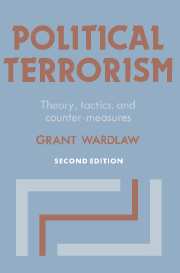Book contents
- Frontmatter
- Contents
- Preface to the second edition
- Preface to the first edition
- Part One An introduction to political terrorism
- Part Two Some selected problems in the response to terrorism
- 8 Counter-terrorist policies: fundamental choices
- 9 Terrorism and the media: a symbiotic relationship?
- 10 The role of the army in counter-terrorist operations
- 11 The legal regulation of terrorism: international and national measures
- 12 Counter-measures against terrorism: the intelligence function
- 13 Terrorist hostage-takings
- 14 Counter-measures against terrorism: the role of behavioural science research
- 15 State involvement in international terrorism
- 16 The future of political terrorism
- Notes
- Select bibliography
- Index
12 - Counter-measures against terrorism: the intelligence function
Published online by Cambridge University Press: 05 January 2012
- Frontmatter
- Contents
- Preface to the second edition
- Preface to the first edition
- Part One An introduction to political terrorism
- Part Two Some selected problems in the response to terrorism
- 8 Counter-terrorist policies: fundamental choices
- 9 Terrorism and the media: a symbiotic relationship?
- 10 The role of the army in counter-terrorist operations
- 11 The legal regulation of terrorism: international and national measures
- 12 Counter-measures against terrorism: the intelligence function
- 13 Terrorist hostage-takings
- 14 Counter-measures against terrorism: the role of behavioural science research
- 15 State involvement in international terrorism
- 16 The future of political terrorism
- Notes
- Select bibliography
- Index
Summary
The clandestine nature, organisational principles, and tactics of terrorist groups pose particularly difficult problems for security authorities. In order to take preventive measures, pre-empt planned attacks, deal successfully with terrorist incidents in progress and, when possible, prosecute terrorists they need information. The information they need is not readily available. The only way to obtain it is by intelligence-gathering techniques. This chapter will seek to outline the features of terrorism that make intelligencegathering vital to counter-terrorist operations and to briefly indicate the types of intelligence techniques which are used in the struggle against terrorism.
The importance of surprise
A well-organised and coherent terrorist group strives for secrecy in order to maximise the advantages afforded by surprise. It should be noted that in order to be effective, surprise need not be total, although effectiveness may be directly related to degree of surprise. The US Army definition of surprise recognises this. Surprise is defined as: ‘Striking an enemy at a time and place and in a manner for which he is unprepared. It is not essential that the enemy be taken unaware, but only that he becomes aware too late to react effectively.’
- Type
- Chapter
- Information
- Political TerrorismTheory, Tactics and Counter-Measures, pp. 131 - 146Publisher: Cambridge University PressPrint publication year: 1989
- 2
- Cited by



